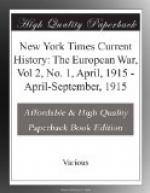In the meanwhile, even though food may be provided, the reduction of industry in general has cut incomes right and left. That is, fewer goods are produced and exchanged. But goods are the basis of all credit. The less the goods exchanged, the less the credit operations. Nevertheless, the extraordinary issues of banknotes, the increase of deposits, as a result of quintupling the loans, means that former commitments in goods and securities cannot be liquidated. That is, the enormous increase of bank liabilities, to a considerable and unknown percentage, is not supported by liquid assets. These assets are “canned.” Will they keep sweet? There is no new business, no foreign trade, sufficient to take up old obligations and renew those which are unpayable. Lessened incomes mean lessened consumption and lessened demand for goods. Hence the credit system is based on an uncertain and insecure foundation, dependent wholly upon contingencies far in the future which may, or may not, take the non-liquid assets out of cold storage and give them their original value.
Moreover, apart from definite destruction of wealth and capital in the war—which must be enormous, as represented by the national loans—the losses from not doing business in all main industries during the whole period of the war (except in making war supplies) must be very great. As it affects the income and expenditure of the working classes, it may be roughly measured by the great numbers of unemployed. If they are used on public works, their income is made up from taxes on the wealth of others. Luxuries will disappear, and not be produced or imported. Incomes expressed in goods, or material satisfactions, have been diminished—which is of no serious consequence, if they cover the minimum of actual subsistence. The prolongation of the war will, then, depend on the ability to provide the supplies for war.
The need for a medium of exchange is oversupplied. The lack is in the goods to be exchanged. The enormous extension of German note issues does not, and can not, diminish. In this country the expansion of credit and money immediately after the war (manifested by the issue of Clearing House certificates and emergency banknotes) has been cleared away by liquidation. In Germany the “canned” assets behind the depreciated currency cannot be liquidated until the end of the war. And their worth at that time will depend much on the future course of the war and the terms of peace. If German territory should be overrun and the tangible forms of capital in factories and fixed capital be destroyed, much of the liquidation might be indefinitely prolonged. Whatever of foreign trade is permanently lost would also increase the difficulties.




